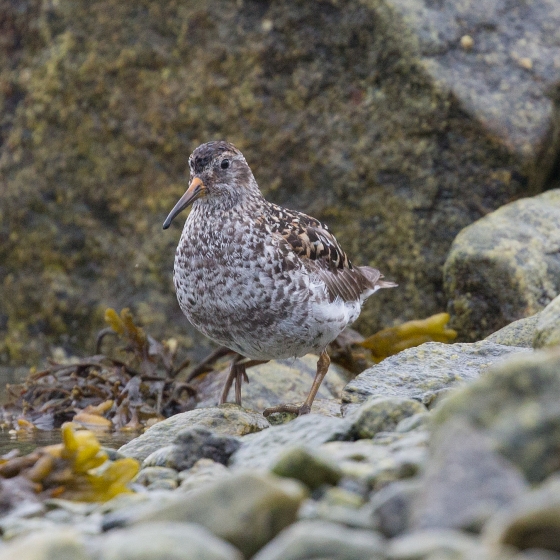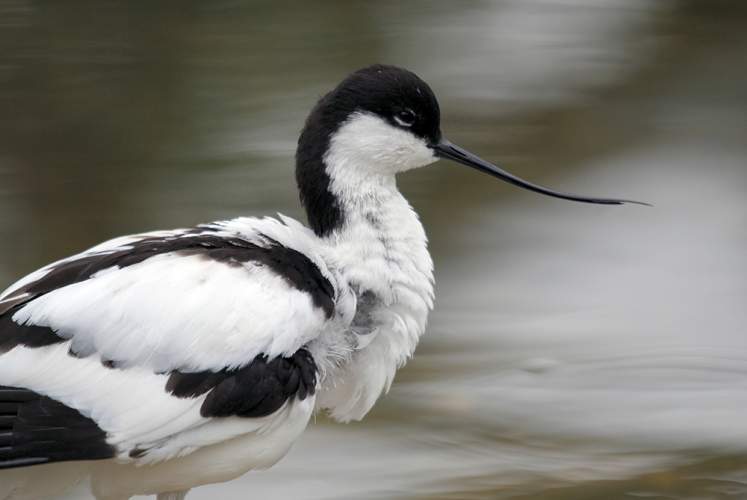Purple Sandpiper
Calidris maritima (Brünnich, 1764)
PS
 PURSA
PURSA  5100
5100

Family: Charadriiformes > Scolopacidae

This hardy wader is found on exposed rocky shores in winter; only its breeding plumage is purple-tinged.
Never common as a breeding bird, with only a handful of pairs recorded in northern Scotland, the Purple Sandpiper is now a less than annual breeder. A plump, stocky wader with distinctive yellow legs it is distributed around almost all coasts in winter, only being scarce in southern and eastern England.
Ringing records show that Purple Sandpipers are remarkably faithful to wintering sites, with individuals returning to the exact same stretch of coast year after year.
Identification
Purple Sandpiper identification is sometimes difficult.
SONGS AND CALLS
Listen to example recordings of the main vocalisations of Purple Sandpiper, provided by xeno-canto contributors.
Call
Develop your bird ID skills with our training courses
Our interactive online courses are a great way to develop your bird identification skills, whether you're new to the hobby or a competent birder looking to hone your abilities.
Browse training coursesStatus and Trends
Population size and trends and patterns of distribution based on BTO surveys and atlases with data collected by BTO volunteers.
CONSERVATION STATUS
This species can be found on the following statutory and conservation listings and schedules.
POPULATION CHANGE
| UK winter population |
-15% decrease (1996/97–2021/22)  |
DISTRIBUTION
Purple Sandpipers prefer northern, exposed, shallow rocky shores in winter. High concentrations occur along the coasts of the northern North Sea, Northern Isles and Outer Hebrides and around exposed headlands in Ireland. Elsewhere, occupied areas around Wales and southeastern and southern England hold very few birds. Purple Sandpiper is among the UK's rarest breeding species, with occasional breeding in the Scottish Highlands.
Occupied 10-km squares in UK
| No. occupied in breeding season | 2 |
| % occupied in breeding season | 0.07 |
| No. occupied in winter | 522 |
| % occupied in winter | 17 |
European Distribution Map
DISTRIBUTION CHANGE
| % change in range in winter (1981–84 to 2007–11) | +11.3% |
SEASONALITY
Purple Sandpipers are winter visitors; returning birds can arrive from June onwards.

Movement
Information about movement and migration based on online bird portals (e.g. BirdTrack), Ringing schemes and tracking studies.
RINGING RECOVERIES
View a summary of recoveries in the Online Ringing Report.
Foreign locations of birds ringed or recovered in Britain & Ireland

Biology
Lifecycle and body size information about Purple Sandpiper, including statistics on nesting, eggs and lifespan based on BTO ringing and nest recording data.
SURVIVAL & LONGEVITY
View number ringed each year in the Online Ringing Report
Maximum Age from Ringing 
|
15 years 2 months 27 days (set in 1997) 
|
Typical Lifespan 
|
6 years with breeding typically at 2 year |
Adult Survival 
|
0.795±0.028  
|
BIOMETRICS
Wing Length 
|
Adults | 131.8±4.1 | Range 125–138mm, N=1533 |
| Juveniles | 130.4±3.9 | Range 123-136mm, N=115 |
Body Weight 
|
Adults | 70.8±9 | Range 57.0–86.0g, N=1524 |
| Juveniles | 67.6±7.6 | Range 55.0–80.0g, N=114 |
Feather measurements and photos on featherbase 
CODES & CLASSIFICATION
Ring size 
|
B+ or C2 |
Field Codes 
|
2-letter: PS | 5-letter code: PURSA | Euring: 5100 |
For information in another language (where available) click on a linked name
Research
Interpretation and scientific publications about Purple Sandpiper from BTO scientists.
PUBLICATIONS (2)
Aggressive behaviour and correlates of dominance in Purple Sandpipers Calidris maritima at a communal winter roost

Consequences of population change for local abundance and site occupancy of wintering waterbirds
Wavering Waterbirds
Protected sites are assigned based on population statistics for vulnerable and endangered species. This new study using WeBS data shows that changes in population size can affect local abundance, and thus influence whether or not key targets are met for site protection.
Links to more studies from ConservationEvidence.com
Would you like to search for another species?













Share this page